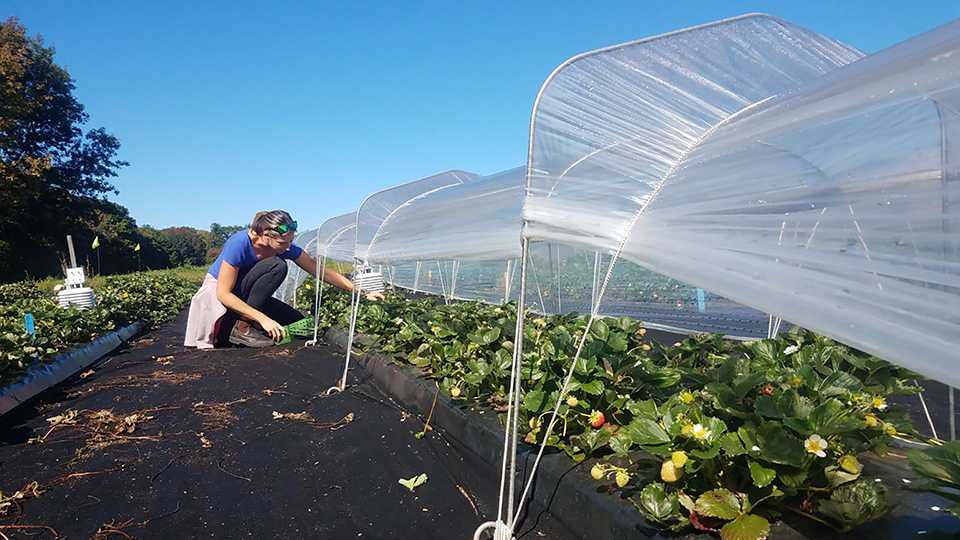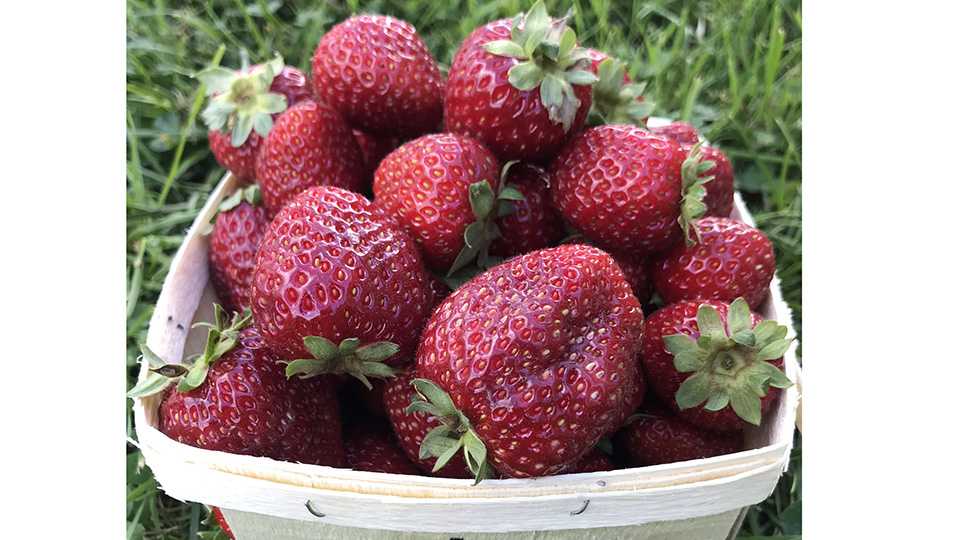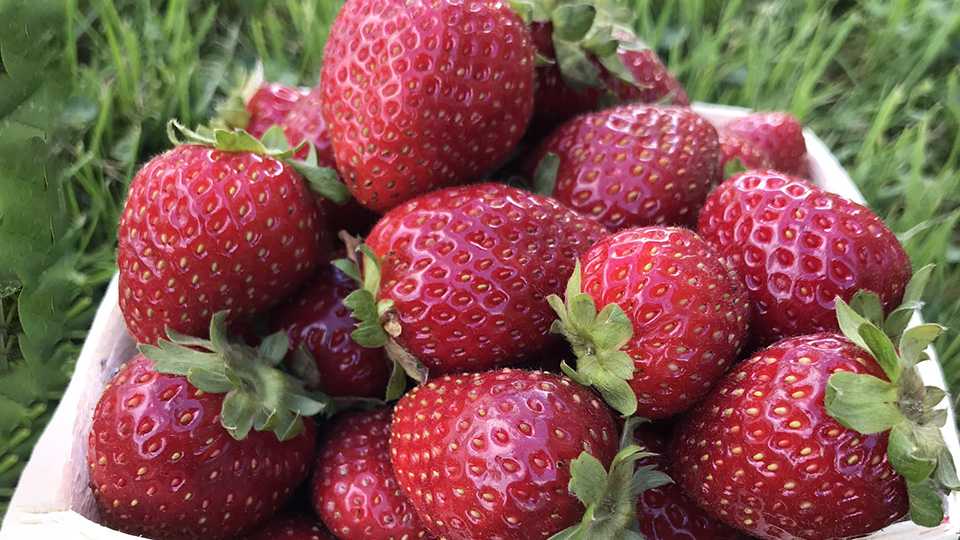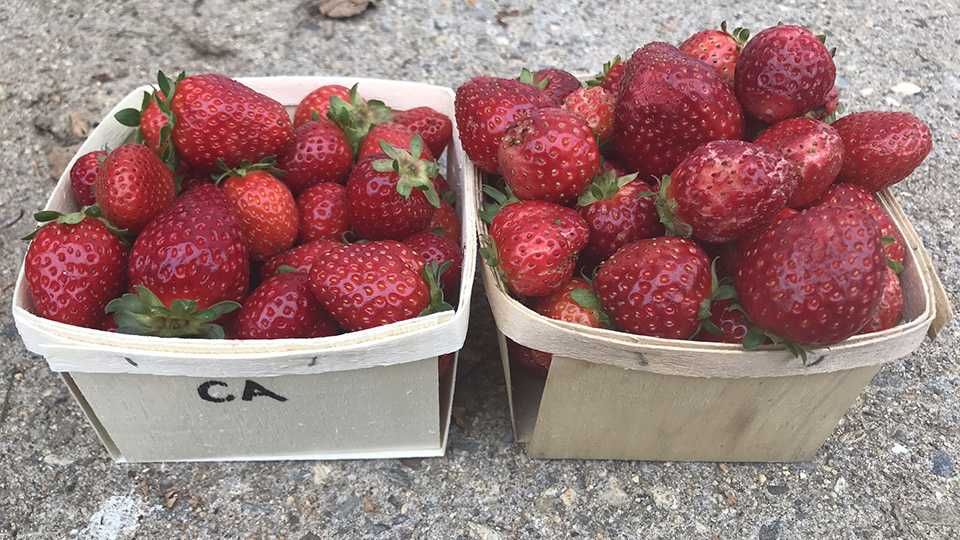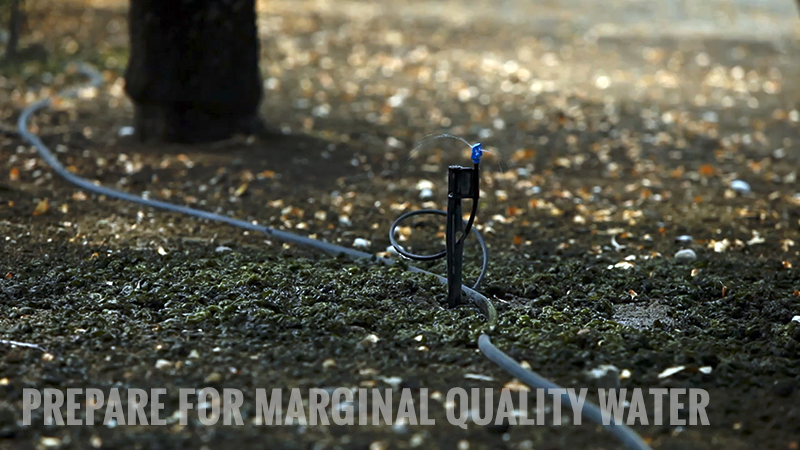Massive Change in Order for Northeast Berry Industry

When Kaitlyn Orde first tasted a New England-grown, day-neutral strawberry — the type commonly grown in such large production areas as California — she knew she and her colleagues at the University of New Hampshire were onto something.
“I was most surprised by how good the eating quality was for some of these day-neutral varieties. There is a belief that the varieties developed on the West Coast for shipping are not as good as the varieties grown here, but that’s just not true,” she says. ‘Albion’, in particular, is excellent. It’s comparable to a June-bearer for sure.”
Taking the supposed superior taste of the June-bearers traditionally grown in her part of the country out of the equation is huge, considering the results of a recent study by Orde and her colleagues at the New Hampshire Agricultural Experiment Station. They more than doubled the annual yield of strawberries and quadrupled the length of the New Hampshire harvest season by growing day-neutral varieties under low tunnels and on traditional open beds.
The results come at the conclusion of the five-year, multi-state TunnelBerries project. The new research, which consisted of several experiments at the Woodman Horticultural Research Farm, provides a road map for growers seeking to increase local production during what is normally considered the off-season for locally grown strawberries.
“Our study shows that local strawberries can be grown from early summer through late fall in our area. This is yet another illustration of the diversity of crops that can be grown in this part of the country during months that were previously considered the off-season,” says Orde, who worked with Experiment Station Researcher Becky Sideman, Professor of Sustainable Agriculture and Food Systems and UNH Cooperative Extension Professor and Specialist in Sustainable Horticulture Production.
Researchers evaluated eight varieties of day-neutral strawberries: ‘Albion’, ‘Aromas’, ‘Cabrillo’, ‘Monterey’, ‘Portola’, ‘San Andreas’, ‘Seascape’, and ‘Sweet Ann.’ These varieties produced fruit from early-July into November in both years. Traditionally, New Hampshire’s season for locally grown strawberries is short, only four to six weeks, spanning from mid-June until early July.
They found strawberry variety had a significant effect on marketable yield, the percent marketable yield, runner initiation, fruit sugar content, and plant size. Depending on the variety, annual total yields ranged from 7,600 pounds per acre to greater than 14,000 pounds per acre. The results were obtained using a relatively low planting density. Orde estimates yields could be increased further if plants were grown at slightly higher planting densities.
“Given that New England growers recently have reported average annual yields of 5,900 pounds per acre to the USDA, these are quite competitive yields for our region,” she says.
JUNE-BEARERS NOW RULE
In New England, strawberries are grown entirely differently than in the high-production regions of the U.S. like California. Most New England growers don’t grow day-neutral berries, only short-day plants, Orde explains. They are planted in the summer, cared for throughout the entire first year of growth, and then protected in the winter. Most growers use a matted row system, with straw mulch, not plastic mulch, though there is a movement underway to convert to plastic.
The short-day plants are strongly affected by day-length and only initiate flower buds under cool temperatures and short-day conditions, so they don’t flower until spring when growers remove the winter protection — either row cover or straw. There is just one flush of flowering and subsequent fruit production, resulting in a brief period of fruit production each year.
“They provide us with a really amazing strawberry season, basically throughout the month of June. Growers here don’t even use [the term] short-day plants; growers here call them June-bearers,” she says. “But while June-bearing varieties are very productive over a short harvest season, they inherently limit availability of regionally produced strawberries during the remainder of the year, so instead, we import strawberries from elsewhere.”
Orde believes New England growers could really profit by adding day-neutral berries, which less affected by day-length than short-day berries and will continue fruiting for a longer period of the growing season. The dormant, bare-rooted plants are planted very early in the spring and will generally begin fruiting in 10 weeks.
“Both researchers and several growers have successfully grown day-neutral varieties in our region and have found them to be high-quality and high-yielding. However, prior to our work, there were no replicated studies in Northern New England,” Orde says.
The study shows day-neutral can definitely be grown in her part of the country, she says.
“When grown in combination with June-bearers, growers can offer strawberries from early June until November ― five months. You’re adding four months on by adding the day-neutrals, and the yields are quite good through September,” she says. “In the first year of the study, ‘Aromas’, ‘Albion’, and ‘Monterey’ all produced over 10,000 pounds per acre of marketable fruit. Furthermore, for June-bearers, growers have to wait a full year for a crop, where day-neutrals fruit in their first year.”
But even if yields slack off toward November, growers can make great money from the locally produced delectable fruit, Orde says.
“One year we were picking ‘Albion’ Thanksgiving week,” he says. “It’s really a great fruit crop to offer in the fall.”
At the very least, by growing day-neutral varieties, growers can continue farming strawberries through the summer and fall.
“With June-bearers, you have hail and rain during peak production, and growers can lose a substantial portion of their crop,” she says. “Day-neutrals allow us to diffuse that risk. Yes, you might still lose fruit during June, but the plants keep flowering. It’s another tool in the grower’s toolbox.”
VARIETIES VARY
As Orde notes, one additional benefit to the study was there was no published data on the performance of several of the day-neutral varieties in the Northeast, including ‘Sweet Ann’, ‘Cabrillo’, and ‘Aromas’. And though there was data on other varieties from Cornell University, there was none on how they perform in New England. That doesn’t mean New England growers haven’t been growing day-neutral varieties for several years, with some good success, but there was no published data, meaning Extension folks couldn’t give much advice.
In their study, Orde says they found huge variations among the day-neutral varieties in yield, sugar content, eating quality, runner production, fruiting pattern over the season, and winter hardiness. One interesting note: Orde says they found the soluble solids of day-neutrals grown in New Hampshire to be really high compared to studies done in other areas.
The stars of their study were ‘Albion’ and ‘Monterey’, which were the not only the highest-yielding varieties, their fruit sugar content was greatest in both years. Sugar content also was high in ‘Seascape’, ‘Sweet Ann’, and ‘San Andreas’, with ‘San Andreas’ also being a high yielder. However, ‘San Andreas’ can be tricky.
“Some of the day-neutrals are more finicky; you really have to be in tune with them,” she says. “‘San Andreas’ has been known to taste like cardboard, but my experience is that if allowed to fully ripen, it can be really good. So you really need to train crews on when to pick. With ‘San Andreas’, my personal policy is ‘Wait until tomorrow.’”
Other grower take-aways from the study include that the day-neutral varieties vary tremendously, says Orde.
“The performance of one day-neutral is not reflective of the others. If you’ve tried one, don’t project its performance on the others,” she cautions. “‘Portola’ didn’t do well here. If that was the only day-neutral we tested, I wouldn’t feel day-neutrals were a quality option.”
Another factor, of course, is cultural conditions. For example, ‘Sweet Ann’ definitely is a good quality fruit, but very fragile. Because of that, low tunnels significantly increased marketable yields of ‘Sweet Ann’.
LOW TUNNELS HELP – SLIGHTLY
Low tunnels were also a part of the New Hampshire study, but Orde emphasizes their impact on yields were small compared to growing day-neutral varieties. However, they did find that low tunnels increased the percent marketable yield by about 10% in both years of the study and increased marketable yields during the last six weeks of the 2018 season, from mid-September to late-October.
During the final six weeks of the 2018 season, plants growing under low tunnels produced 850 pounds per acre more than plants growing on open beds (no low tunnels), which is estimated at about $3,800 in additional revenue from low tunnels during this late-season period.
Orde and Sideman also found that low tunnels reduced runner initiation for several varieties. “Together, we found that plants grown under low tunnels required less labor for the removal of cull fruit and runners and produced a higher percentage of marketable yield,” Orde says.
The primary advantage to low tunnels is their effect on fruit quality, and that they can provide growers piece of mind should rain or hail hit at the wrong time.
“When low tunnels are integrated, they have very positive effects on fruit quality following precipitation,” she says. “For harvests immediately following significant rain, 3% fruit have been marketable on open beds, but 50 – 70% have been marketable under low tunnels. They’re really like an insurance policy.”
While low tunnels may have had only positive effects in the study, Orde says they can be costly, about $20,000 per acre for a commercial system.
“However, growers are accustomed to investing money in many kinds of tools that pay off under different circumstances,” she says. “Given time, they will eventually pay off.”
That said, Orde is cautious about promoting low tunnels as a silver bullet for strawberry farmers.
“It’s really the day-neutral plants that allow growers to remain in this market for the long season,” she says.
And that, in a society that increasingly values locally sourced fruits, is the name of the game.
“Customers want fresh berries for a much longer season,” she says. “Let’s capitalize on that and participate in this market.”
For More Information
Additional resources available for growers on the New Hampshire study are available from UNH Cooperative Extension and the American Society for Horticultural Science publication, HortTechnology:
- Low Tunnel Guide: https://extension.unh.edu/resources/files/Resource007429_Rep10703.pdf
- Day-Neutral Guide: https://extension.unh.edu/resources/files/Resource007790_Rep11405.pdf
- HortTechnology: https://doi.org/10.21273/HORTTECH04317-19
For more on growing berries in tunnels, check out the comprehensive website: https://www.tunnelberries.org/
Like this article? Go ahead and click the “Applause” button below. And feel free to leave a reader comment.




